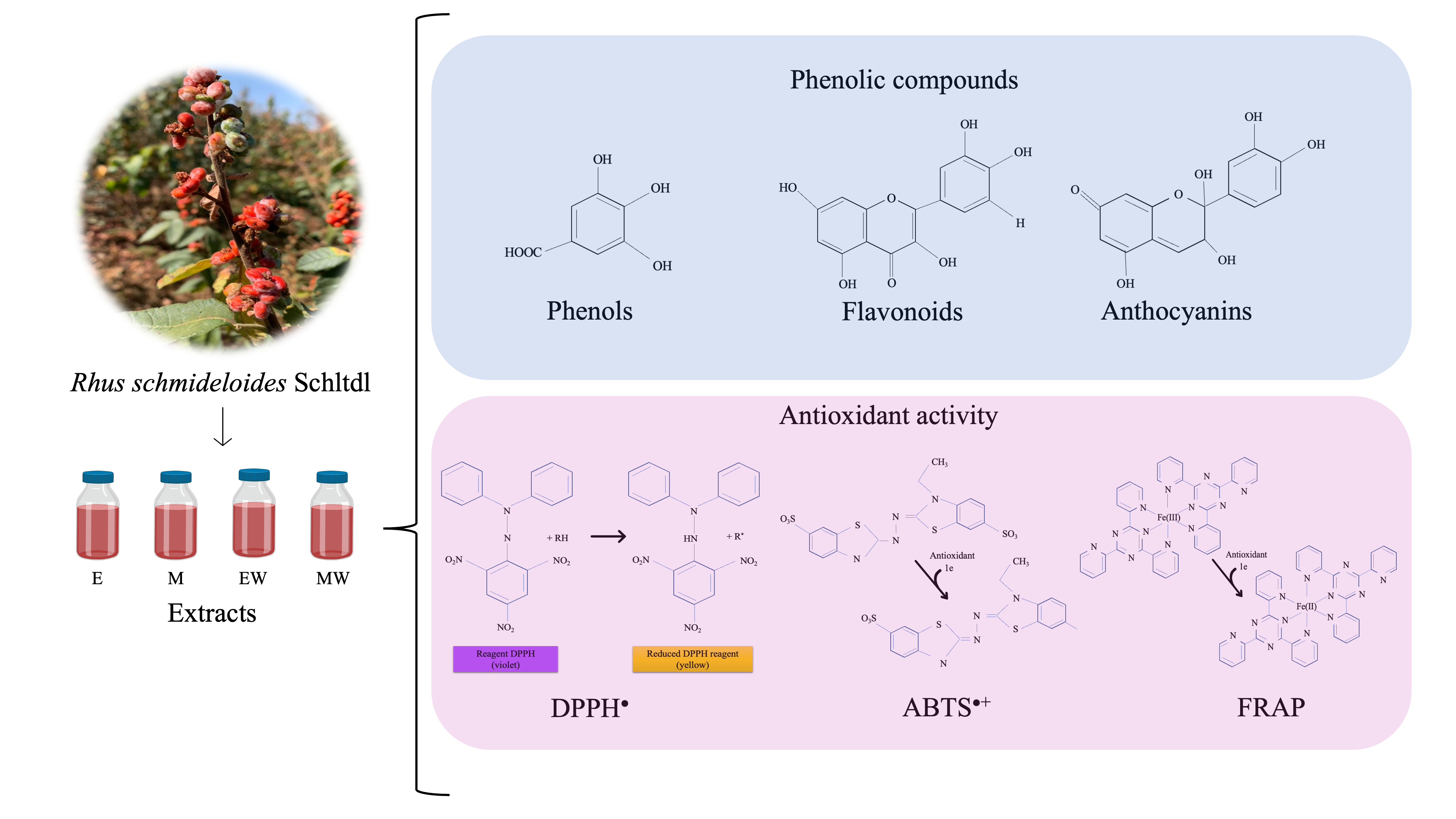Phenolic Compounds and Antioxidant Activity of the Rhus aromatica var. schmidelioides (Schltdl.) Engl. Fruit Extracts
DOI:
https://doi.org/10.29356/jmcs.v69i3.2169Keywords:
Rhus aromatica var schmidelioides (Schltdl.) Engl., phenolic compounds, antioxidant activityAbstract
Abstract. The fruit of Rhus aromatica var. schmidelioides (Schltdl.) Engl. (RHSC) is commonly consumed for the properties attributed to it in traditional medicine. However, to the best of our knowledge, there is no information on the bioactive compounds present in the species. The content of phenolic compounds and the antioxidant activity of the RHSC fruit were evaluated in different extracts: methanol (M), ethanol (E), ethanol-water (MW), and ethanol-water (EW). The values obtained in each extract were compared, and it was found that the highest value for total phenol was EW, for total flavonoids it was E, and for anthocyanin, it was M. While for antioxidant activity the highest value obtained for DPPH was MW, for ABTS it was EW and for FRAP it was M. In general, the antioxidant activity could be verified in all extracts. This study corresponds to the first report on the content of phenolic compounds and antioxidant activity in different extracts, highlighting that the RSS fruit contains a high content of compounds with antioxidant properties.
Resumen. El fruto de Rhus aromatica var schmidelioides (Schltdl.) Engl. (RHSC), es comúnmente consumido por las propiedades que se le atribuyen en la medicina tradicional. Sin embargo, hasta donde sabemos no existe información de los compuestos bioactivos presentes en la especie. El contenido de compuestos fenólicos y la actividad antioxidante del fruto de RHSC fueron evaluadas en diferentes extractos: metanol (M), etanol (ET), metanol-agua (MA) y etanol-agua (EA). Al comparar los valores obtenidos en cada extracto se encontró que el valor más alto para fenoles totales fue en EA, para flavonoides totales fue E y para antocianinas fue M. Mientras que para la actividad antioxidante el mayor valor obtenido para DPPH fue MA, para ABTS fue EA y para FRAP fue M. En general, se pudo comprobar en todos los extractos la actividad antioxidante. Este estudio corresponde al primer informe sobre el contenido de compuestos fenólicos y la actividad antioxidante en diferentes extractos, resaltando, que el fruto de RSS contiene un alto contenido de compuestos con propiedades antioxidantes.
Downloads
References
Andrés-Hernández, A. R.; Terrazas, T.; Salazar, G.; Ochentera, H. Bot. J. Linn. Soc. 2014, 176, 452-468. DOI: https://doi.org/10.1111/boj.12222.
López, F. G. A.; Olivares, N. S.; Orozco, E. M.; Gómez, S.I.; García, Y.R. Rev. Ra Ximhai. 2022, 18, 291-314.
Rayne, S.; Mazza, G. Plant Foods Hum. Nutr. 2007, 62, 165-175. DOI: https://doi.org/10.1007/s11130-007-0058-4.
Varela-Rodríguez, L.; Sánchez-Ramírez, B,; Saenz-Pardo-Reyes, E.; Ordaz-Ortiz, J. J.; Castellanos-Mijangos, R. D.; Hernández-Ramírez, V. I.; et al. Plants. 2021, 10, 2074. DOI: https://doi.org/10.3390/plants10102074.
Yi, T.; Miller, A. J.; Wen, J. Mol. Phylogenet. Evol. 2004, 33, 861-879. DOI: https://doi.org/10.1016/j.ympev.2004.07.006.
Rahman, M. M.; Rahaman, M. S.; Islam, M. R.; Rahman, F.; Mithi, F. M.; Alqahtani, T.; et al. Molecules. 2022, 27, 233. DOI: https://doi.org/10.3390/molecules27010233.
Liu, Z.; Ren, Z.; Zhang, J.; Chuang, C. C.; Kandaswamy, E.; Zhou, T.; Zuo, L. Front. Physiol. 2018, 9, 477. DOI: https://doi.org/10.3389/fphys.2018.00477.
Alqasoumi, S. I.; Basudan, O. A.; Alam, P.; Abdel-Kader, M. S. Pak. J. Pharm. Sci. 2016, 29, 97-103.
Shahat, A. A.; Ibrahim, A. Y.; Al-Ghamdi, A. A. M.; Alsaid, M. S. Trop. J. Pharm. Res. 2016, 15, 1697-1706. DOI: http://dx.doi.org/10.4314/tjpr.v15i8.15. DOI: https://doi.org/10.4314/tjpr.v15i8.15
Alqahtani, A. S.; Abdel-Mageed, W. M.; Shahat, A. A.; Parvez, M. K.; Al-Dosari, M. S.; Malik, A.; et al. J. Food Drug Anal. 2019, 27, 758-765. DOI: https://doi.org/10.1016/j.jfda.2019.02.002.
Jang, J. Y.; Shin, H.; Lim, K. T.; Ahn, J. H.; Jo, Y. H.; Lee, K. Y.; et al. PLoS ONE. 2018, 13, e0200257. DOI: https://doi.org/10.1371/journal.pone.0200257.
Nam, T. G.; Lee, B. H.; Choi, H. K.; Mansur, A. R.; Lee, S. G.; Kim, D. O. J. Microbiol. Biotechnol. 2017, 27, 1090-1097. DOI: https://doi.org/10.4014/jmb.1612.12018.
Lee, J. C.; Lim, K. T.; Jang, Y. S. Biochim. Biophys. Acta. 2002, 1570, 181-191. DOI: https://doi.org/10.1016/S0304-4165(02)00196-4.
Asgarpahan, J.; Saati, S. Res. J. Pharmacongn. 2014, 1, 47-54.
Singleton, V. L.; Rossi, J. A. Am. J. Enol. Vitic. 1965, 16, 144-158. DOI: https://doi.org/10.5344/ajev.1965.16.3.144.
Morales, G.; Paredes, A. BMC Complement. Altern. Med. 2014, 14, 259. DOI: https://doi.org/10.1186/1472-6882-14-259.
Lee, J.; Durst, R. W.; Wrolstad, R. E. J. AOAC Int. 2005, 88, 1269-1278. DOI: https://doi.org/10.1093/jaoac/88.5.1269.
Brand-Williams, W.; Cuvelier, M. E.; Berset, C. L. W. T. Food Sci. Technol. 1994, 28, 25-30. DOI: https://doi.org/10.1016/S0023-6438(95)80008-5.
Benzie, I. F.; Strain, J. J. Methods Enzymol. 1999, 299, 15-27. DOI: https://doi.org/10.1016/S0076-6879(99)99005-5.
Wang, L.; Xu, M. L.; Guo, L. J.; Liu, J.; Wang, L. S. Adv. J. Food Sci. Technol. 2015, 7, 223-229. DOI: http://dx.doi.org/10.19026/ajfst.7.1299. DOI: https://doi.org/10.19026/ajfst.7.1299
Wu, T.; McCallum, J. L.; Wang, S.; Liu, R.; Zhu, H.; Tsao, R. Food Chem. 2013, 138, 1333-1340. DOI: https://doi.org/10.1016/j.foodchem.2012.10.086.
Belew, A. A.; Meshesha, D. S.; Akele, M. L. Int. J. Adv. Res. 2021, 4, 503-515. DOI: https://doi.org/10.21203/rs.3.rs-1207023/v1.
Varela-Rodríguez, L.; Sánchez-Ramírez, B.; Rodríguez-Reyna, I. S.; Ordaz-Ortiz, J. J.; Chávez-Flores, D.; Salas-Muñoz, E.; Talamás-Rohana, P. BMC Complement. Altern. Med. 2019, 19, 126. DOI: https://doi.org/10.1186/s12906-019-2566-9.


Downloads
Published
Issue
Section
License
Copyright (c) 2025 Gabriel Alejandro Reveles-Hernández, Jesús Nicodemo González-Gallegos, Evelia Martínez-Cano

This work is licensed under a Creative Commons Attribution-NonCommercial 4.0 International License.
Authors who publish with this journal agree to the following terms:
- Authors retain copyright and grant the journal right of first publication with the work simultaneously licensed under a Creative Commons Attribution License that allows others to share the work with an acknowledgement of the work's authorship and initial publication in this journal.
- Authors are able to enter into separate, additional contractual arrangements for the non-exclusive distribution of the journal's published version of the work (e.g., post it to an institutional repository or publish it in a book), with an acknowledgement of its initial publication in this journal.









